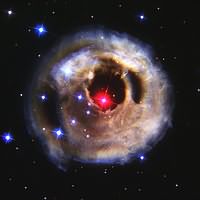 Though one can undoubtedly attempt to justify the Hubble Space Telescope from a utilitarian perspective, I think it is also one of the great luxuries of western civilisation, an immense nonproductive expenditure (Hubble's cumulative costs up to 1999 are estimated to be between 4.5 and 6 billion USD and Europe's financial contribution is estimated at 593 million Euros) that was made just to portray the exuberant beauty of the universe, the prodigious glory of its planets and stars and nebulae, pulsars, quasars, black holes, and galaxies.
Though one can undoubtedly attempt to justify the Hubble Space Telescope from a utilitarian perspective, I think it is also one of the great luxuries of western civilisation, an immense nonproductive expenditure (Hubble's cumulative costs up to 1999 are estimated to be between 4.5 and 6 billion USD and Europe's financial contribution is estimated at 593 million Euros) that was made just to portray the exuberant beauty of the universe, the prodigious glory of its planets and stars and nebulae, pulsars, quasars, black holes, and galaxies.Of course, one could maintain that the object of the Hubble Space Telescope Project is to expand the domination of human knowing (as opposed to the night of non-knowing) to the very limits of time and space, to conquer space intellectually (that is virtually, not in actuality); and that therefore, the Hubble Space Telescope is diametrically opposed to potlach squandering. However; like the Pyramids, the Aztec hecatombs and the Tibetan Lamaist system, a project such as the Hubble Space Telescope can be polyvalent, functioning both as an expansionist project and as a nonproductive expenditure at the same time. While for the small community of scientists actually working with the Hubble Space Telescope the expansionist project may be dominant, the aspect of the Telescope as a beautific squandering may be more powerful in the psychological life of the larger public.
Seen from this perspective the NASA and STScI photos made by the Hubble Space Telescope and displayed on the gallery of the Hubble Heritage Project website are our Aztec Pyramids: the platforms on which we sacrifice our riches. And what platforms! The beauty of the photographs of alien galaxies can certainly rival that of any of the seven wonders of the ancient world.




No comments:
Post a Comment